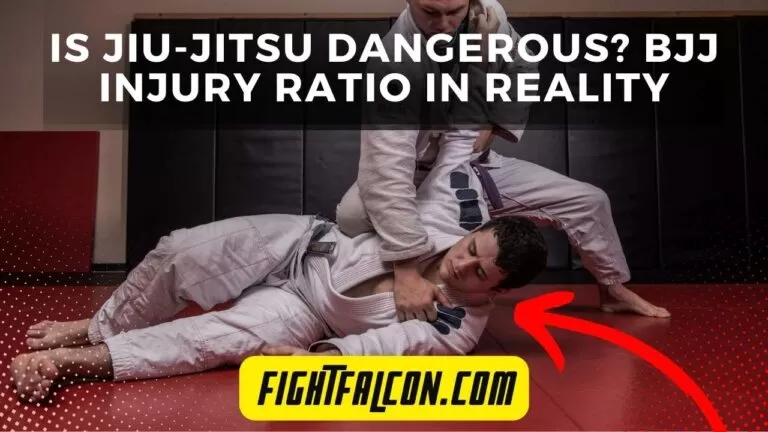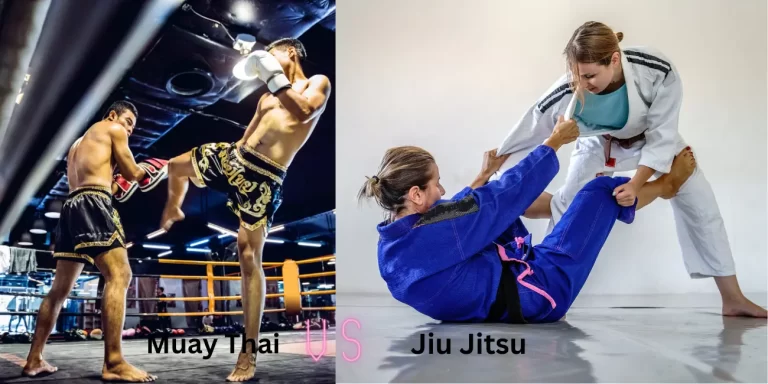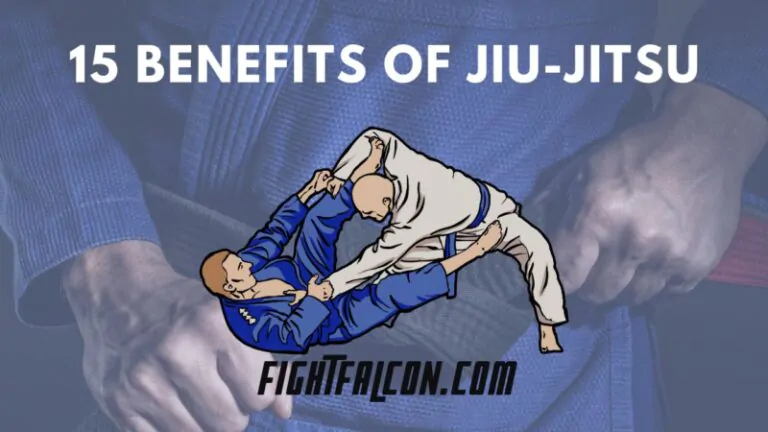Top 10 Jiu-Jitsu Positions That You Must Know
Jiu-Jitsu is a world-famous martial art that has attracted millions around the world. Before professionally entering Jiu-Jitsu, players need to know about all the positions that set the basis for Jiu-Jitsu. You must know how to do these moves and escape from them if the opponent uses them.
The basic moves of Jiu-Jitsu include The Guard, Side Control, Turtle Position, Mount Position, Knee on Belly, and Rear Mount. Once you have a good grasp on those, you can move on to the advanced positions, i.e., Spider Guard, De La Riva Guard, 50/50 Guard, and X Guard.
The Jiu-Jitsu world has more positions and moves than you could ever imagine. But these are some of the most important ones. Let’s look into them in more detail.
Six Basic Jiu-Jitsu Positions

There are 6 basic positions you need to know about Jiu-Jitsu professionally.
1. The Guard
The Guard is a fundamental position in Jiu-Jitsu where you’re down on your back, dealing with your opponent, who is over you.
There are four types of basic Guard positions:
- Closed Guard. Your legs are wrapped around your opponent. You are in control of them, restricting their movement.
- Open Guard. Legs aren’t fully wrapped around, allowing for increased mobility and various attacks.
- Butterfly Guard. The seated position with knees bent and feet on the floor offers offensive and defensive options.
- Half Guard. Your opponent controls one leg while the other is free, developing a dynamic defensive position.
Guards act as a shield. They prevent your opponent from advancing and scoring points. Guards can also be utilized as openings to submissions like armbars and triangles, turning defense into an attack.
2. Side Control
Side Control is a pivotal position in Jiu-Jitsu. It differs a lot from the Guard.
In Side Control, one player is chest-to-chest on top of the other, and the other bodies are perpendicular. The fighter on top is the attacker. It’s a position of dependence with a major strategic significance.
Key Features
- Side Control is often the goal while escaping an opponent’s Guard. It signifies a successful advancement past the Guard, placing you in a dominant role.
- Side Control offers a launching pad for numerous attacks and transitions. From right here, you can progress to more dominant positions like Mount or Back Control.
- Efficient use of energy is critical in Jiu-Jitsu. Side Control allows you to conserve strength while preserving control. Passing the Guard and securing Side Control demand some heavy skills, each contributing to overall proficiency.
- For the man or woman in Side Control, preventing escapes is paramount. It’s a position where you can neutralize your opponent’s moves and dominate.
3. Turtle Position
The Turtle position occurs when one fighter is on arms and knees, with the head tucked in, and the other is on their back.
How It’s Used
- It is used as a shielding stance when the opponent has surpassed your Guard but has yet to achieve Side Control. It denies the opponent 3 points for a guard pass, a tactical move in the match.
- Provides a chance to reset and re-guard, turning a dangerous situation into a more steady one.
- Offers a second possibility to correct the mistakes made during the initial engagement.
- While effective, the Turtle comes with the chance of revealing the back. You need to make quick and informed decision-making.
- Strategic deployment can cause sudden takedowns, changing the fight’s direction.
4. Mount Position (4 Points)
Mount occurs when the top player straddles the bottom player. He kneels over them with gravity working in their favor.
Key Features
- It’s the champion of positions, making the fighter at the top the dominant. Being at the top means you may go for all kinds of movements, making lifestyles tough for the player below.
- A warning, though. Even though you are in control, one wrong move and you could lose it. Your neck and arms are the most vulnerable here. You need to keep them safe. One slip, and you’re in trouble.
- Escaping the Mount is a skill in itself. It involves calculated movements and creating opportunities for yourself. Successful escapes from Mount can shift the momentum of the game. This shows the dynamic nature of Jiu-Jitsu.
- In Jiu-Jitsu competitions, achieving the Mount position earns the top player four valuable points. These points are heavy on the scoreboard and add to the opponent’s psychological pressure.
5. Knee on Belly (2 Points)
The top player positions their knee on the opponent’s stomach while keeping balance and control.
Key Insights
- It is often used during guard passes. The knee on the belly is a transition point where you quickly transfer from one role to another.
- It provides an opportunity for side control. This adds a vast array of moves to the top player’s arsenal.
- The knee position on the opponent’s stomach exerts pressure. This makes it uncomfortable and induces a sense of urgency in the opponent. Strategic weight distribution allows the fighter on top to control the fight’s tempo.
- Unlike fixed positions, the Knee on Belly allows quick adjustments and fluid motion. It keeps the opponent guessing. This mobility opens avenues for submissions and increases the threat posed by the top player.
- In Jiu-Jitsu, Knee on Belly earns you two points. It reflects the positional dominance and capability for further attacks. These points contribute to the overall strategy. It influences the scoreboard and the opponent’s attitude.
6. Rear Mount / Back Control (4 Points)
Rear Mount, or Back Control, is when you’re on your opponent’s back with your legs wrapped around them.
Key Insights:
- Getting Rear Mount in Jiu-Jitsu is like winning at chess. It sets you up for powerful attacks.
- Your legs around your opponent give you a chance to make them tap. Like the Rear Naked Choke, famous actions come from here, making your opponent submit.
- In Jiu-Jitsu competitions, Rear Mount scores big with four points, showing you’re in charge. These points display dominance and put you on the path to winning.
- You can get to Rear Mount in different ways, from standing to ground moves. It’s adaptable and surprising. Like a quiet hunter, you can patiently wait for the right moment to grab or go for a submission.
4 Advanced Jiu-Jitsu Positions

Moving on from the basics, here are a couple of advanced techniques you need to know about:
1. Spider Guard
Spider Guard is when you use your legs to control your opponent’s arms.
Think of it like a puppeteer pulling the strings. You are dictating your opponent’s movements. It’s a strategic position for launching assaults and sweeps.
2. De La Riva Guard
The De La Riva Guard involves hooking in the back of your opponent’s leg in an advanced open guard.
How Does it Work? You use your opponent’s moves towards them, setting up defense and offense. It’s a stationary position, and you can use it for smooth transitions.
3. 50/50 Guard
The 50/50 Guard is a symmetrical position wherein both fighters have equal opportunities.
It’s like a chess match, with every move having calculated risks and rewards.
With 50/50 Guard, submissions become the language of negotiation, supplying strategic benefits.
4. X-Guard
X-Guard is a dynamic guard where one leg is connected to the other for submissions and sweeps.
How it Works: It disrupts your opponent’s balance and turns every movement into a potential submission. It’s not just about sweeps; it is a move after which a submission becomes inevitable.
Frequently Asked Questions
What are the fundamental Jiu-Jitsu positions that every player should know?
Some of the foundational Jiu-Jitsu positions include the Guard, Side Control, Knee on Belly, Mount, Rear Mount, and Turtle. These moves have further types that fighters adopt, all linked to each other.
What is the number one position in Jiu-Jitsu?
The Mount position is often considered one of the most dominant and advantageous. It provides significant control over the opponent and opens up various submission opportunities.
Why is it called the 50/50 Guard?
The 50/50 Guard is called that for its symmetrical nature. It gives equal opportunities for both fighters. It turns submissions into a strategic negotiation.
How do the advanced Jiu-Jitsu positions contribute to a fighter’s approach?
The advanced positions, including Spider Guard, De La Riva Guard, 50/50 Guard, and X-Guard, are strategic positions that provide control, possibilities for assaults, and the fluidity of transitioning between strategies.
Conclusion
To sum it up, mastering Jiu-Jitsu positions, from the foundational Guard to superior ones like Spider Guard or 50/50 Guard, is key to success. These positions provide strategic advantages to the fighters and set the stage for effective attacks and defenses.
Whether you’re a beginner or exploring superior strategies, continued learning and practice are the keys to fulfillment in Jiu-Jitsu.







